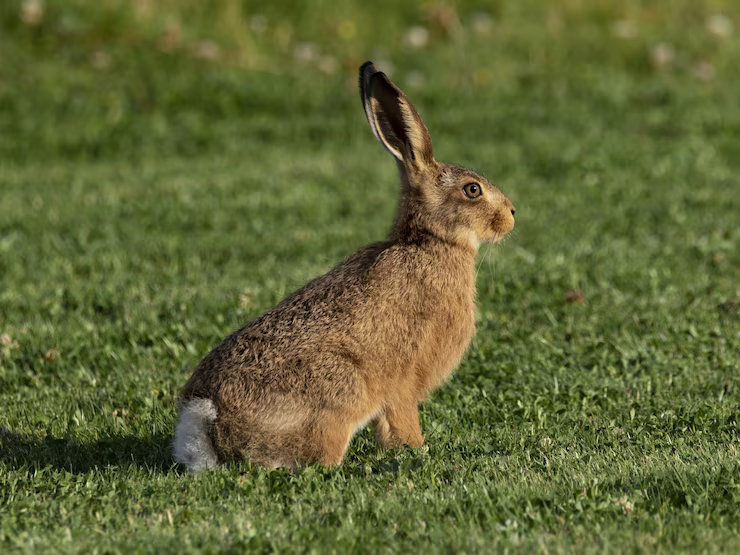Wild Rabbit: A Complete Guide to Their Life in Nature
Wild rabbit
- Profile Wild Rabbit
- Size 35-45 cm
- Velocity 56 km/h
- Weight 1.3-2.2 kg
- Lifetime 3-4 years
- Food Grasses, herbs, leaves
- Foes Red fox, marten, weasel, lynx, badger, birds of prey, owls
- Distribution Europe, Australia, America
- Habitat Loose, sandy soils, parks, gardens
- Order Hare-like
- Family Hares
- Scientific. Name Oryctolagus cuniculus
- Characteristics Small grey-brown hare, archetype of the domestic rabbit
Features & Special Characteristics of Wild Rabbits
The first time I saw a wild rabbit, I was hiking through a field at sunset. It had short ears, soft gray-brown fur, and those powerful back legs that help it leap like a little ninja. Unlike hares that usually keep to themselves, wild rabbits are like the social butterflies of the animal world—they love living in groups and often build entire underground neighborhoods called burrows. It’s like their version of a cozy community!
Wild rabbit

Where Do Wild Rabbits Live?
You might think rabbits only live in forests, but wild rabbits are world travelers—well, sort of! They originally lived all over Europe (except way up north in places like Iceland and parts of Scandinavia). But humans brought them to places like Australia, New Zealand, and even the Americas hundreds of years ago. While that may have sounded like a good idea at the time, it didn’t always go well. In some areas, the rabbit population grew too fast and caused problems for local farms and wildlife.
Habitat
Wild rabbits prefer loose, sandy soil where they can dig burrows and tunnels. They also live near villages and cities because parks and green spaces provide them with living space.
Behavior and Lifestyle
Let me tell you a fun memory—once while I was visiting a village, I spotted a group of wild rabbits hopping around a garden in broad daylight! Normally, these little creatures are most active at dawn and dusk, but when they feel safe near humans, they sometimes come out during the day. They live in tight-knit families and spend most of their time either munching on plants or chilling in their underground homes. These tunnels can be surprisingly deep—up to 3 meters! And one tunnel system can stretch as long as 45 meters. That’s almost half a football field!
Wild rabbit

Physique and appearance
Size and weight
Wild rabbits are small and narrow. They have a body length of 35-45 cm. Their ears are 6-8 cm long and their tail is 4-7 cm. Their weight is 1.3-2.2 kg.
Fur
Wild rabbits have a thick upper coat that protects them from injury. In winter, they have a soft, warming undercoat.
Whiskers
Wild rabbits have long, black whiskers. They help them to perceive their environment better.
Tail
Wild rabbits have a short tail. When they are on the run and run away, the white underside becomes visible. It is like a “signpost” and helps the other rabbits to follow and get to safety.
Color
Wild rabbits are grey-brown, sand-coloured, dark grey or even black.
Nutrition
Rabbits are herbivores. They feed mainly on grasses, herbs and leaves. From time to time, they also eat bark and twigs.
Wild rabbits in front of their burrow

Behaviour
Whistles and drums
When predators are nearby, rabbits warn each other. They whistle and knock on the ground with their hind legs.
Rabbit hole
Size
Rabbits build tunnels and burrows underground. Their burrow can be up to 3 m deep and up to 45 m long. It offers space for 2-10 animals.
Entrance
The entrance is easy to see because it has a diameter of 10-50 cm and is free of grasses or other plants.
Tunnelling :Rabbits dig tunnels by pushing soil to the hind legs with their front paws and then throwing it away with them.
Always close by: Usually, rabbits only move 25-50 m away from their burrow so that they can quickly get to safety at any time.
Wild rabbit
Wild rabbit – Photo: Sciencia58 [CC BY-SA 4.0], via Wikimedia Commons
Abilities and senses
Hearing
Wild rabbits have excellent hearing. You can hear very low and very high tones. Their ears are also very mobile. You can rotate it 270 degrees and rotate it in the direction you want like a satellite dish. In addition, they can hear independently of each other with their ears, for example one sound with the left and another with the right.
Sense of sight
The eyes are located on the side of her head. As a result, wild rabbits have a field of vision of almost 360 degrees. You can quickly spot predators no matter which direction they’re coming from.
Smell
Wild rabbits have an excellent sense of smell. They have about 100 million olfactory cells. With their help, they can smell enemies even if they are still far away, and even smell food that is underground. The sense of smell also plays a major role in their social life. They recognize their conspecifics by smell and mark their territory with smells.
Life expectancy
Wild rabbits rarely live longer than 3-4 years in the wild. The oldest wild rabbit living in the wild was 7 years and 7 months old.
Wild rabbits in his burrow

Enemies and threats :
Natural enemies
Wild rabbits have many enemies. They are prey animals for red foxes, martens, weasels, polecats, stoats, lynxes, wolves, badgers, dogs, birds of prey and owls.
The human being
Wild rabbits are often referred to as a plague because they reproduce too much in some places. But humans are to blame for this. The animals were imported to Australia, for example. There they had no natural enemies, multiplied very strongly and have since caused great damage to young plants, shrubs and crops. Hunting is not always a helpful means of limiting the number of animals. When wild rabbits are shot, the surviving conspecifics feel a so-called “reproductive pressure”. They notice that their relatives are missing and reproduce more often as a result.
Endangerment status
According to the IUCN, the wild rabbit is an endangered species because its numbers have declined sharply in recent years in its original distribution area (Spain and Portugal). The reason for this is diseases caused by viruses and parasites, overhunting and loss of habitat.
at would otherwise have no chance of thriving. Their droppings are also rich in nutrients that
Wild Rabbit: Test Your Knowledge!
Discover how much you know about the wild rabbit’s behavior, senses, and fascinating lifestyle. Take this fun 5-question quiz!
Q1: What is the average lifetime of a wild rabbit in the wild?
Q2: What is the main function of a wild rabbit’s white tail?
Q3: How deep and long can a rabbit burrow be?
Q4: Which sense helps rabbits detect predators even underground?
Q5: Why is hunting not always effective in controlling rabbit populations?








One Comment